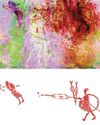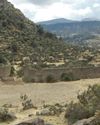
THE KHOE AND SAN PEOPLES have created rock art in southern Africa for millennia. On the walls of rock shelters throughout the region, artists painted finely rendered depictions of dancers and hunters, as well as animals such as the eland, the world's largest antelope. For well over a century, scholars have studied what these rock canvases reveal about ancient Khoe-San beliefs and traditions. But in the rugged mountains of South Africa's Eastern Cape Province there are other, more recent works that offer a glimpse of the violent world the Khoe-San endured after Europeans began to settle the region in the late eighteenth century. The Khoe-San living in the Winterberg Mountains reacted to attempts by colonizers to seize their land and enslave their people by raiding European settlements, to devastating effect. Paintings made during this period depict Khoe-San cattle raiders on horseback, sometimes wielding guns and wearing wide-brimmed European-style hats as they drive herds to their hideouts. Contemporaneous panels nearby depict baboons and ostriches, animals revered by the Khoe-San for their ability to evade capture, as well as antelopes, which played an important ritual role. Only in the past decade have scholars begun to recognize what this rock art reveals about how Khoe-San raiders and their allies among formerly enslaved peoples originally from elsewhere resisted European colonization.
This story is from the May/June 2023 edition of Archaeology.
Start your 7-day Magzter GOLD free trial to access thousands of curated premium stories, and 8,500+ magazines and newspapers.
Already a subscriber ? Sign In
This story is from the May/June 2023 edition of Archaeology.
Start your 7-day Magzter GOLD free trial to access thousands of curated premium stories, and 8,500+ magazines and newspapers.
Already a subscriber? Sign In

A Very Close Encounter
New research has shown that human figures painted in red on a rock art panel in central Montana depict individuals engaged in a life-or-death encounter during an especially fraught historical moment.

A Sword for the Ages
A zigzag pattern, now tinged with the green-blue patina of oxidized metal, adorns the octagonal hilt of a rare sword dating to the Middle Bronze Age in Germany (1600-1200 B.C.) that was recently excavated in the Bavarian town of Nördlingen.

Ancient Egyptian Astrology
For centuries, layers of soot have coated the ceilings and columns in the entrance hall of Egypt's Temple of Esna. Now, an Egyptian-German team of researchers, led by Hisham El-Leithy of the Egyptian Ministry of Tourism and Antiquities and Christian Leitz of the University of Tübingen, is restoring the temple's vibrant painted reliefs to their original brilliance.

BRONZE AGE POWER PLAYERS
How Hittite kings forged diplomatic ties with a shadowy Greek city-state

RITES OF REBELLION
Archaeologists unearth evidence of a 500-year-old resistance movement high in the Andes

Secrets of Egypt's Golden Boy
CT scans offer researchers a virtual look deep inside a mummy's coffin

When Lions Were King
Across the ancient world, people adopted the big cats as sacred symbols of power and protection

UKRAINE'S LOST CAPITAL
In 1708, Peter the Great destroyed Baturyn, a bastion of Cossack independence and culture

LAPAKAHI VILLAGE, HAWAII
Standing beside a cove on the northwest coast of the island of Hawaii, the fishing village of Lapakahi, which is surrounded by black lava stone walls, was once home to generations of fishers and farmers known throughout the archipelago for their mastery of la'au lapa'au, or the practice of traditional Hawaiian medicine. \"

A MORE COMFORTABLE RIDE
Although the date is much debated, most scholars believe people 5,000 years ago. For thousands of years after that, they did so without saddles. \"In comparison with horse riding, the development of saddles began relatively late, when riders began to care more about comfort and safety in addition to the horse's health,\" says University of Zurich archaeologist Patrick Wertmann.